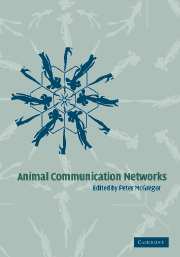Book contents
- Frontmatter
- Contents
- List of contributors
- Preface
- 1 Introduction
- Part I Behaviours specific to communication networks
- Part II The effects of particular contexts
- Introduction
- 7 Enlightened decisions: female assessment and communication networks
- 8 Predation and noise in communication networks of neotropical katydids
- 9 Nestling begging as a communication network
- 10 Redirection of aggression: multiparty signalling within a network?
- 11 Scent marking and social communication
- Part III Communication networks in different taxa
- Part IV Interfaces with other disciplines
- Index
11 - Scent marking and social communication
Published online by Cambridge University Press: 06 August 2010
- Frontmatter
- Contents
- List of contributors
- Preface
- 1 Introduction
- Part I Behaviours specific to communication networks
- Part II The effects of particular contexts
- Introduction
- 7 Enlightened decisions: female assessment and communication networks
- 8 Predation and noise in communication networks of neotropical katydids
- 9 Nestling begging as a communication network
- 10 Redirection of aggression: multiparty signalling within a network?
- 11 Scent marking and social communication
- Part III Communication networks in different taxa
- Part IV Interfaces with other disciplines
- Index
Summary
Introduction
The use of chemical scents for communication between individuals is widespread among both vertebrate and invertebrate animals. Scent signals emanating from an animal's body can be used for intimate and immediate communication when two or more individuals interact at close quarters, but scents can also be deposited in the environment in the form of scent marks. Unlike most visual or acoustic signals used by animals, scent marks persist in the absence of the signaller, often over extended periods. The prolonged duration of signals in deposited scent marks makes them particularly suited for broadcasting information to all conspecifics that visit a scent-marked site. Further, scent marks might be deposited to signal to certain individuals, such as when animals are attempting to attract potential mates or to indicate a territorial boundary to neighbours. Once deposited in the environment, however, the scent is not physically directed towards specific recipients and the information will be available to any other animals in the locality. This ready availability of scent marks to third parties is likely to provide strong selection pressure to ensure that the information deposited in scent marks is appropriate for communication to any individual likely to encounter the scent. Consequently, scent marks are likely to have evolved to be used for network communication rather than as signals between specific individuals.
While volatile components of the scent may be detected at some distance from a scent mark, alerting animals to the presence and location of scent signals, non-volatile components can be detected only by close contact investigation.
- Type
- Chapter
- Information
- Animal Communication Networks , pp. 219 - 244Publisher: Cambridge University PressPrint publication year: 2005
- 20
- Cited by

